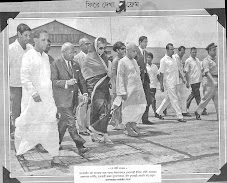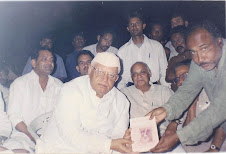SP set to sweep UP with 232-250 seats: CNN IBN exit poll
Troubled Galaxy Destroyed Dreams, chapter 752
Palash Biswas
http://indianholocaustmyfatherslifeandtime.blogspot.com/
http://basantipurtimes.blogspot.com/
Dalal Street Nervous ahead of elections!LIC investment in ONGC a daylight robbery!
Small policyholders of the country's largest life insurer are carrying the can for the government's ambitious disinvestment programme.
ONGC today said LIC picked up 37.71 crore shares in the company during the auction last week and its total holding has gone up to 9.48%.State-owned Life Insurance Corporation (LIC) pumped in over Rs12,000 crore and purchased 95% of the equity put on the block in the first-ever stake sale of ONGC through auction process.BJP today described the handling of auction of ONGC shares as another example of government's "policy paralysis" and alleged that shareholders of LIC, which was roped in to buy the over-priced shares, have been unduly penalised.
Taking into account the average price of Rs303.67 a share, the country's largest insurer would have invested around Rs11,450 crore during the first ever auction of PSU shares on March 1.
Despite LIC's bailout, Siddharth Pradhan, additional secretary of the Department of Disinvestment tells CNBC-TV18 that they do not regret setting the ONGC auction floor price at a premium. "If we had given a discount, the government would have lost about Rs 2000 crore," he said.
The government today received Rs 12766 crores from the ONGC auction in its account which will go towards fulfilling FY12's divestment target. In a filing to exchanges, ONGC said that over 88% of the shares on offer were bought by LIC.
Pradhan goes on to say that they have not yet received any official indication as to what went wrong with the auction process. "We have heard that the goof up was done by the Stock Holding Corporation, but unless I get an authentic report, I can't go and take action against anybody," he said.
Life Insurance Corporation (LIC) has bought 37.71 crore shares representing 4.41% stake in ONGC through open
market purchase, ONGC said in a filing to the BSE.LIC, according to official sources, picked up 40 crore shares, or 95% of the ONGC shares, sold through the auction route yesterday fetching the government a total of Rs12,766.75 crore.
The government auctioned 5% of its stake, or 44.77 crore shares, of ONGC on March 1, fetching Rs12,767
crore to the exchequer.
While the ONGC auction was subscribed 98.3%, LIC has picked up over 84% of the shares on offer. The remaining was bought by institutional and retail investors.
With the acquisition of 4.41%, LIC's stake in ONGC has gone up to 9.48%, the filing added. As per the Insurance regulator IRDA guidelines, an insurance firm's holding should not exceed 10% in any company.
Shares of ONGC is trading at Rs282.85, up 0.71% on the BSE in the afternoon trade today.
The CNN-IBN-The Week-CSDS exit poll has projected that Samajwadi Party will get a convincing majority in Uttar Pradesh by bagging 232 to 250 seats in the 403-member Assembly.Widely tipped to bag Uttar Pradesh, Samajwadi Party chief Mulayam Singh Yadav Monday declined to comment on the likely electoral outcome Tuesday but said "all sections" supported his party.Even as his son Akhilesh Yadav spoke to some television channels, the senior Yadav did not meet the media while discussing the situation in the country's most populous state with his senior colleagues.
The markets ended on a negative note on Monday with both Indian benchmark indices closing in the red owing to discouraging growth data from China and nervous sentiment over UP election results due on Tuesday.The Nifty was down 1.47 per cent to close at 5,281, losing about 80 points while the Sensex fell by 1.55 per cent or 274 points and closed at 17,363. The realty and metal stocks were the worst hit and registered a fall of over three per cent on the bourses.Reliance Infra, Reliance Power, Tata Motors, ITC and Wipro were the top five Nifty gainers while JP Associates, Hindalco, DLF, GAIL and SAIL were the losers on the Nifty.
After market participants rejected the investment and silently condemned LIC's last-minute purchase of ONGC shares to help the issue sail through, the criticism has got political.
There was no participation from foreign institutional investors and very little from retail investors, sources said. About 42 crore ONGC shares, representing a little less than 5% of government stake in the oil major, were sold at an average price of Rs 303.67 a piece.
Meanwhile, talking to reporters Disinvestment Secretary Haleem Khan said, "We got bids for 42.1 crore shares...it comes to 98% (of the issue size). In terms of volume, we received bids worth Rs 16,460.2 crore and out of that Rs3,693.29 crore worth bids were rejected. Bids worth Rs12,766.75 crore were accepted."
On whether the government will sell stake in more PSUs through the auction route, he said, "It will depend upon case-to-case basis, definitely on the strength of the company, market and investor interest.
"If we analyse (that) this process will give us better results as good as this result...we can continue with it (auction route)", he added.
Earlier in the day, Finance Minister Pranab Mukherjee had said, "this (ONGC auction) is the first case. We shall have to analyse and then make an assessment."
The high-voltage ONGC auction was marred by technical glitches but scraped through after intervention by the Finance Ministry and Securities and Exchange Board of India (Sebi).
"This is daylight robbery," BJP leader Yashwant Sinha said. "LIC is a captive source of funds for the government. They have misused the status of LIC to misappropriate policyholders' money and brought it to the government's coffers through the ONGC disinvestment."Sinha, chairman of the Parliamentary Standing Committee on finance, was commenting on what is being seen as virtual arm-twisting of Life Insurance Corporation of India (LIC) by the government to invest in the auction of ONGC shares the government was disinvesting. Because of acute lack of investor interest in the issue, it almost bombed.
That was when the government got into action and reportedly got LIC to buy more than Rs 11,450 crore worth of shares, about 84% of the total auctioned last week. As a result, policyholders of Life Insurance Corporation of India (LIC) are sitting on a notional loss of Rs 900 crore.
"I hope to god that this is the last time that they misuse and misappropriate the funds of public sector undertakings and try to bridge the fiscal deficit by this strategy," the former finance minister said.
The question is how to make LIC autonomous such that government interference does not hamper its role as the guardian of policyholders' money. "This needs to be answered, needs to be looked into in detail. But adhoc measures are not the answer. Appropriating their surplus and pushing them into losses is not the way."
Had any private sector company done this, the government's investigative agencies would have sprung into action within minutes. Insurance Regulatory and Development Authority (IRDA), the insurance regulator, for instance, would have asked difficult questions.
"If there are regulatory issues, IRDA needs to deal with it," Sinha said. "There must be a level playing field between LIC and other private insurers. Just because LIC has been formed under an Act of Parliament doesn't mean it is debarred from regulatory oversight."
Capital markets regulator Securities and Exchange Board of India would have launched an inquiry as to how a transaction so large was allowed after market had closed. The government's view that "technical glitches" botched up the issue is not an argument that would be allowed to any private promoter.
"There were certain buy orders which were not immediately confirmed or were erroneously rejected by custodians due to a mismatch at the custodian end, even though, the orders were funded," the two exchanges said in a joint statement. So, while the exchanges seem to be in the clear, the role of the custodian, Stock Holding Corporation of India, remains fuzzy. Is it going to be the fall guy?
Finally, this transaction would have faced questions on governance — that is, how the government bypassed the entire board and got LIC to part with policyholders' money in just a few hours.
"Why should the government take a decision on behalf of any PSU, including LIC? The government has its representative on the board and whatever ideas you want to give should be given through this representative," Sinha said.
Bringing the fiscal deficit under control is crucial --- but not at the cost of market integrity. By indulging in this face-save, the government is sending a strange message to the market: if we can't play cricket, we'll change the field to football.
The CNN-IBN-The Week-CSDS exit poll has projected that Samajwadi Party will get a convincing majority in Uttar Pradesh by bagging 232 to 250 seats in the 403-member Assembly.
On the eve of the counting of votes, the poll, conducted by CNN-IBN-The Week-CSDS, projects that the ruling Bahujan Samaj Party would get only 65 to 70 seats, way below its tally of 206 in the 2007 Assembly elections.
According to the poll, the Congress may end up in the third place with projected 36-44 seats, up from 22 last time, while BJP may bag only 28-38 seats, far behind its tally of 51 seats in 2007 elections.
The poll suggests only 11-23 seats for others.
In terms of vote share, the poll claimed that SP would get 34 per cent, the BSP 24%, followed by the BJP with 14 per cent and Congress at the fourth place with just 12 per cent.
The poll survey also suggests that the Samajwadi Party has done well in all the regions of Uttar Pradesh.
Disinvestment debacle
RAGHUVIR SRINIVASANSHARE · COMMENT · PRINT · T+
The HinduAn ONGC off-shore oil rig in the Arabian Sea. File photo
The ONGC share auction could have bombed but for LIC coming to the rescue
A desperate seller unwilling to compromise on the product's price; a product that is plagued by a major shortcoming; buyers who are aware of both the seller's desperation and the expensive price of the product. What do you get when you combine all these? Answer: a debacle called ONGC disinvestment.
The details are murky but one fact is clear: the auction process for ONGC could have bombed on the government and but for LIC coming to its rescue, the Centre may have been left red-faced with the mortification of seeing its Maharatna's shares having no takers. The insurance major coughed up as much as Rs.12,000 crore of the Rs.12,767 crore raised from the auction, or 94 per cent.
It can never be proved conclusively whether LIC was ordered to bridge the large shortfall in demand. Circumstantial evidence, however, offers some pointers. Until 3.20 p.m. on the day of the auction, only 1.43 crore shares were bid for on the BSE and NSE. It is difficult to believe that bids for the balance 40.6 crore shares were made in the remaining 10 minutes before the offer closed at 3.30 p.m.
Second, the details of the bids were declared close to midnight on Thursday, eight hours after the auction closed. Why did it take so long for the bids to be tabulated? The auction was screen-based and the exchanges have efficient computer systems that have handled several big ticket initial public offerings (IPOs) in the past. So the explanation of glitches is not convincing and the exchanges have also clarified there were no technical problems.
Third, it is also difficult to believe that institutional investors putting in large bids will wait until the last 10 minutes of the auction. One explanation being given is that they were waiting for the indicative price to be declared by the exchanges. This did not happen because there were just 1.43 crore shares bid and the exchanges could not arrive at the indicative price from them. The fact is that all bidders, not just institutional, could see the trends live on the websites of the exchanges and were aware that the indicative price might not be announced. The question of indicative price arises only if there is excessive demand which was not the case with the ONGC auction.
The evidence, therefore, points in the direction of possible intervention by the government to save the auction. That institutions such as LIC and others have in the past been treated as handmaidens of the government only bolsters the case. It might well be that LIC will make handsome gains from the investment at some point in the future. Yet, that should not be confused with whether it is right for the government to lean on such institutions to bail it out of a tricky situation of its own making. The test question is: Would LIC have invested such a large sum in a single stock on its own volition?
WRONG ON THREE COUNTS
The government has only itself to blame for the debacle. It went wrong on three major counts: price, timing and the quality of the asset. The base price of Rs.290 set for the auction was way too high. The ONGC stock has a 52-week average high/low price of Rs.276 while the average price in the last month was Rs.289. The mistake was to price the share using the latter benchmark.In a disinvestment or, for that matter, even in an IPO, it is always prudent to price the offer in such a way that there is something left on the table for investors. The government failed to do that with ONGC.
A discount on price was also important because the stock came loaded with risk not the least of which is the propensity of the government to make the upstream oil companies such as ONGC bear a greater share of the subsidy burden when oil prices rise, as they are doing now. ONGC was sharing a third of the subsidy on petrol and diesel but recently the government hiked it to a little over 37 per cent. With oil prices moving up further, there is no guarantee that this ratio will not be increased.
Finally, the timing was all wrong. For one, the market, despite the uptrend in indices in the last few weeks, is still nervous about the fundamental prospects for the economy. Growth is faltering and government finances are getting weaker with the fiscal deficit target for the entire year being overrun in just 10 months until January. This was no time to hit the market with a Rs.12,000 crore offer priced fully, if not excessively, and in a company subject to the overhang of subsidy-sharing.
Also, investors were aware of the government's desperation to bridge the fiscal deficit with proceeds from the auction, especially with barely a month left for the end of the financial year. What this means is that the seller, which is the government, began with a handicap and the only way of overcoming that was by pricing the product attractively. The government failed to do that.
It is important that lessons are learnt. The idea of an auction is itself a good one but it is important to time it correctly, generate excitement before the event and then set the price at an attractive level. Failing to do these will lead to debacles such as the ONGC disinvestment.
Keywords: ONGC disinvestment, ONGC auction, Life Insurance Corporation, LIC ONGC shares
http://www.thehindu.com/business/companies/article2957922.ece
| LIC policyholders carry disinvestment can |
| Notional losses on insurer?s PSU shopping spree at Rs 3,038 crore or 25 per cent of investment |
| N Sundaresha Subramanian & Deepak Korgaonkar / Mumbai Mar 05, 2012, 00:56 IST |
Small policyholders of the country's largest life insurer are carrying the can for the government's ambitious disinvestment programme. Almost all of Life Insurance Corporation (LIC) of India's investment calls in the government's disinvestment programme that restarted in 2009 have gone wrong, resulting in huge notional losses for policyholders in the underlying schemes.
According to data compiled by the BS Research Bureau, LIC has invested around Rs 12,400 crore in seven recent divestment issues since 2009, accounting for a quarter of more than Rs 45,000 crore through public offers in the past two years. The BS Research Bureau compiled the data from the quarterly shareholding filings of 13 state-owned firms which participated in the disinvestment programme since 2009.
These holdings are worth Rs 9,379 crore at current prices. On a cumulative basis, this investment has seen an erosion of 24.5 per cent till date, resulting in a notional loss of Rs 3,038 crore. Unless there is a dramatic turnaround in the markets, these losses will eventually get passed on to the policyholders who have purchased insurance policies and unit-linked investment plans.
This is excluding last week's last-minute investment in the Rs 12,766-crore offer for sale of ONGC shares. Losses are expected to swell if the seven per cent post-auction fall in the explorer's share prices is taken into account.
LIC has been investing money collected from individuals in savings and insurance schemes, buying huge chunks of government shares in the disinvestment programme. While the government insists the institution is investing by its "investment rationale", there are not many takers for this theory.
Further, the results produced by the so-called "investment rationale" speak for itself. While the companies it had taken big bets on have seen their share prices tumble, at least four public offers the insurer avoided have performed very well.
Of the seven companies LIC bought stakes in, six are in the red. The biggest losses came in investments such as Shipping Corp (50 per cent), PTC India (41 per cent) and NMDC (39 per cent). In terms of absolute losses, the NMDC investment saw the biggest erosion of Rs 2,293 crore, followed by Rs 654 crore lost in NTPC. In SJVN, which has lost a quarter of its value since its public issue, LIC's Market Plus 1 scheme held 47.5 million shares as of December 2011. However, it is not clear what part of this stake was picked up in the said IPO.
Like in SJVN, the insurer has been trying to make amends by picking additional shares at lower prices in some other counters, too. It has added nearly 56 million shares in Shipping Corporation, 23 million in NTPC and one million in NMDC, according to the shareholding data of these companies for the quarter ended December 2011. Its only primary market investment in the green is the Rs 73-crore investment in Power Grid Corp.
This investment has seen a gain of 22 per cent or Rs 17 crore.
One of the usual explanations has been the institution buys shares for the long term and that these offers provide it an opportunity to pick good stocks for the long term. However, LIC did not buy shares in the biggest and most successful public issue of the country, Coal India, which has gained 35 per cent since. Other successful issues such as OIL India, Rural Electrification and United Bank of India, which have given decent returns to investors, were also inexplicably shunned by the country's largest institutional investor. On the contrary, these issues were lapped up by foreign institutions and private sector funds, who have laughed all the way to the bank.
An email sent to the LIC spokesperson seeking comments did not elicit any response.
In addition to the choice of stocks, the price at which these stocks were picked has also raised eyebrows in the analyst community. Several analysts have questioned the insurer's rationale of picking the ONGC stock, which did not see enough demand at the floor price of Rs 290, at a substantially higher price. The average price of the sale, in which LIC is said to have bought nearly 400 million shares, was Rs 303.
The ONGC sale is fresh in the mind, but LIC has been the lender of last resort for the government's divestment programme ever since it began in mid-2009 after the United Progressive Alliance returned to power, but without the support of Left parties.
The first crisis call came to LIC in early 2010, when the government was pushing the sale of NTPC through a follow-on public offer. The rescue story continued as the insurer picked over 168 million shares in the NMDC FPO, steeply priced at Rs 300. Both these shares are trading much below the FPO levels at Rs 178 and Rs 184, respectively. Engineers India, which offered shares at Rs 290, is now trading at Rs 273.70.
http://business-standard.com/india/news/lic-policyholders-carry-disinvestment-can/466727/






















No comments:
Post a Comment